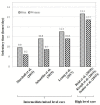Patterns of Sedentary Behavior among Older Adults in Care Facilities: A Scoping Review
- PMID: 33800199
- PMCID: PMC7967434
- DOI: 10.3390/ijerph18052710
Patterns of Sedentary Behavior among Older Adults in Care Facilities: A Scoping Review
Abstract
Understanding the sedentary patterns can guide the design of strategies to engage older adults in physical activity. This scoping review aimed to synthesize available evidence on sedentary behaviors in care facilities. We searched PubMed/MEDLINE and Web of Science for studies published from inception through October 2020. Eighteen studies were included and reviewed according to the Preferred Reporting Items for Systematic reviews and Meta-Analyses (PRISMA) guidelines. Data obtained were analyzed based on levels of care provided. Overall, daily sedentary time was higher among residents in high level care facilities (e.g., nursing homes) (11.6 h/day) than intermediate/mixed level care facilities (e.g., assisted living) (9.5 h/day). In intermediate/mixed level care facilities, television (TV) viewing was the most common sedentary activity (2.5-2.9 h/day; 26% of daily sedentary time), while napping was the most favorite sedentary activity (4.7 h/day; 36% of waking hours) in high level care facilities. Sex differences in daily patterns of sedentary behavior (sedentary time, uninterrupted bouts, and bout durations) were commonly observed in intermediate/mixed level care facilities, as exemplified by men being more sedentary by 0.7-1.1 h/day. In summary, this study highlights distinctive sedentary patterns among older adults residing in different levels of care facilities, addressing a pressing need for customized interventions to engage care facility residents in physical activity.
Keywords: care homes; elderly; inactivity; institutional; lying; mobility; residential aged care; retirement communities; sedentariness; sitting.
Conflict of interest statement
The authors declare no conflict of interest.
Figures



Similar articles
-
Patterns of sedentary behavior among older women with urinary incontinence and urinary symptoms: a scoping review.BMC Public Health. 2024 Apr 30;24(1):1201. doi: 10.1186/s12889-024-18703-7. BMC Public Health. 2024. PMID: 38689284 Free PMC article.
-
Effectiveness of professional oral health care intervention on the oral health of residents with dementia in residential aged care facilities: a systematic review protocol.JBI Database System Rev Implement Rep. 2015 Oct;13(10):110-22. doi: 10.11124/jbisrir-2015-2330. JBI Database System Rev Implement Rep. 2015. PMID: 26571287
-
Physical activity and sedentary behaviour in a residential aged care facility.Australas J Ageing. 2019 Mar;38(1):E12-E18. doi: 10.1111/ajag.12589. Epub 2018 Oct 3. Australas J Ageing. 2019. PMID: 30281184
-
Personal and Environmental Contributors to Sedentary Behavior of Older Adults in Independent and Assisted Living Facilities.Int J Environ Res Public Health. 2020 Sep 3;17(17):6415. doi: 10.3390/ijerph17176415. Int J Environ Res Public Health. 2020. PMID: 32899196 Free PMC article.
-
A systematic review of evidence for older adults' sedentary behavior and physical activity after hip fracture.Clin Rehabil. 2018 May;32(5):679-691. doi: 10.1177/0269215517741665. Epub 2017 Nov 24. Clin Rehabil. 2018. PMID: 29169245
Cited by
-
Effectiveness of Interventions for Reducing Sedentary Behaviour in Older Adults Living in Long-Term Care Facilities: A Protocol for a Systematic Review.Healthcare (Basel). 2023 Jul 8;11(14):1976. doi: 10.3390/healthcare11141976. Healthcare (Basel). 2023. PMID: 37510417 Free PMC article.
-
Physical literacy, health and interactive aging: a position paper.Front Sports Act Living. 2024 Mar 27;6:1346802. doi: 10.3389/fspor.2024.1346802. eCollection 2024. Front Sports Act Living. 2024. PMID: 38600905 Free PMC article. Review.
-
Prevalence of urinary incontinence and associated factors in nursing homes: a multicentre cross-sectional study.BMC Geriatr. 2024 Feb 17;24(1):169. doi: 10.1186/s12877-024-04748-1. BMC Geriatr. 2024. PMID: 38368318 Free PMC article.
-
Barriers associated with the public use of sports facilities in China: a qualitative study.BMC Public Health. 2022 Nov 18;22(1):2112. doi: 10.1186/s12889-022-14441-w. BMC Public Health. 2022. PMID: 36401218 Free PMC article.
-
Determinants of Resting Energy Expenditure in Very Old Nursing Home Residents.J Nutr Health Aging. 2022;26(9):872-878. doi: 10.1007/s12603-022-1837-1. J Nutr Health Aging. 2022. PMID: 36156679 Free PMC article.
References
-
- WHO Ageing and Health. [(accessed on 23 November 2020)]; Available online: https://www.who.int/news-room/fact-sheets/detail/ageing-and-health.
-
- Census and Statistics Department, The Hong Kong Special Administrative Region . Hong Kong Population Projections 2017–2066. Census and Statistics Department; Wan Chai, Hong Kong: 2017.
-
- WHO World Report on Ageing and Health. [(accessed on 23 November 2020)]; Available online: https://apps.who.int/iris/bitstream/handle/10665/186463/9789240694811_en....
Publication types
MeSH terms
LinkOut - more resources
Full Text Sources
Other Literature Sources
Medical

